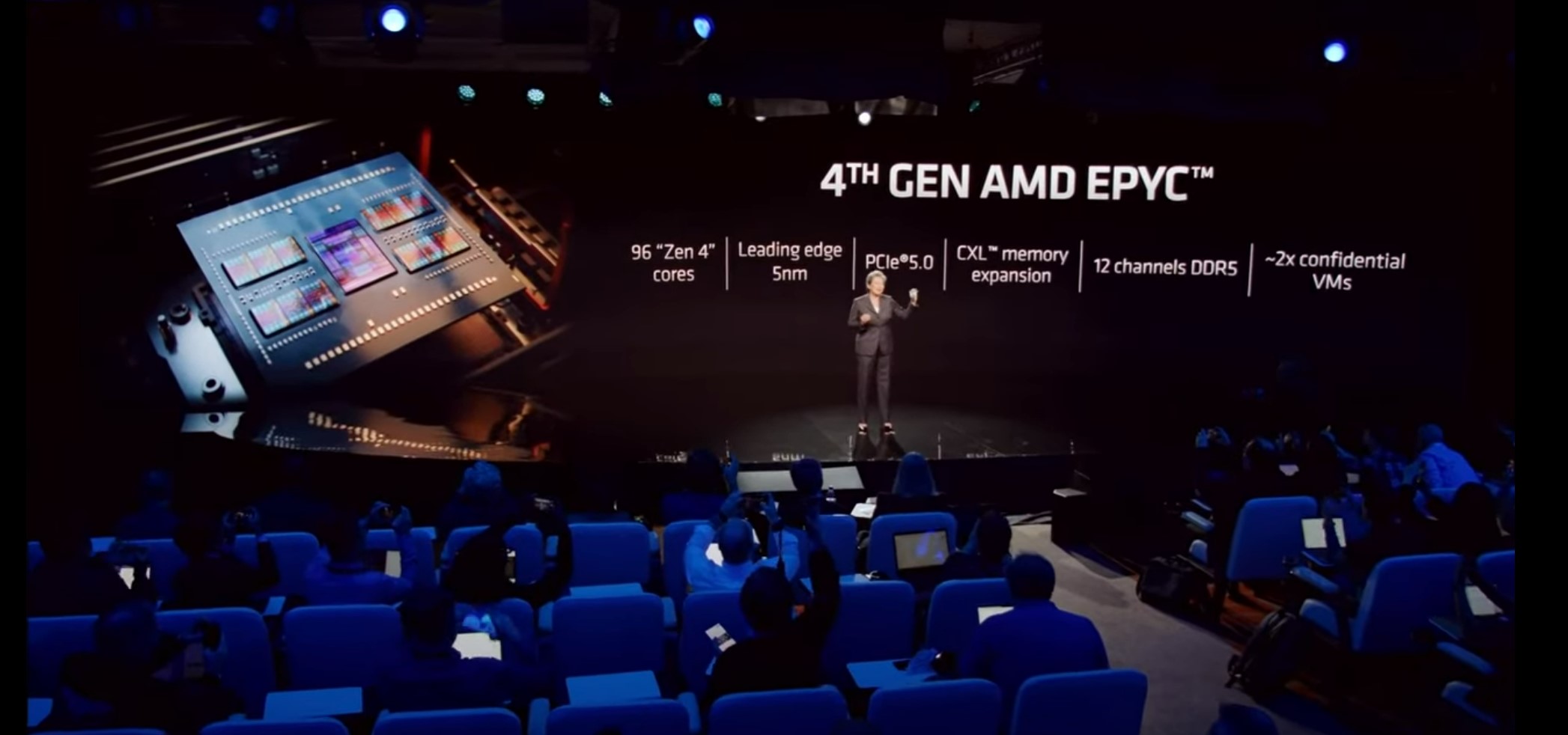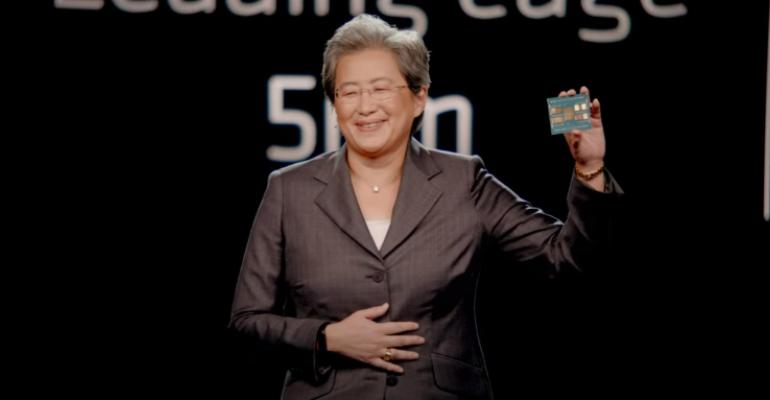AMD executives introduced new Epyc server processors Thursday with a sales pitch that it hopes will resonate with data center operators needing high performance but are worried about rising energy prices and reaching sustainability goals: the CPU is not only the fastest ever, it consumes half the power of its competition.
Built with AMD’s new “Zen 4” core architecture, the new fourth-generation AMD Epyc CPU, code-named Genoa, features up to 96 cores, 32 cores more than AMD’s third-generation Milan chip. With the new processor, AMD also shifted from a 7-nanometer to a 5-nanometer manufacturing process, which improves performance and power efficiency.
At a launch event in San Francisco Thursday, AMD CEO Lisa Su said AMD’s 3rd Gen Epyc was already the world’s highest performing and most efficient server CPU, but the company’s new 4th Gen processor is even better.

“I’m very proud to say 4th Gen Epyc delivers leadership on every dimension. It’s the highest performance. It’s the most efficient. And we’re delivering significantly better performance per watt than our competition,” Su said in a keynote speech. “What that means for enterprises and for cloud data centers, it translates into lower CapEx, lower OpeEx and lower total cost of ownership.”
Those are strong claims, but AMD backs them up with its latest processor innovations, industry analysts say.
The new 4th Gen AMD Epyc processor is the first in the industry to support cutting-edge features like 12 64-bit DDR memory channels, allowing for more memory capacity and bandwidth; CXL 1.1, allowing for memory expansion; and PCIe 5, allowing for higher data throughput – all of which enables significant performance gains, said Manoj Sukumaran, Omdia’s principal analyst of data center compute and networking.
“Hands down, it’s the fastest compute platform in the market,” said Matt Kimball, senior data center analyst at Moor Insights & Strategy. “It’s raw performance, performance per watt and performance per dollar. All its numbers look impressive relative to Milan and to Intel’s current generation Xeon.”
Analysts say the release of the 4th Gen Epyc processor puts AMD in position to grab more market share from chip rival Intel, which has delayed its next-generation Xeon server processor, code-named Sapphire Rapids. Intel isn’t expected to formally launch Sapphire Rapids until the 2023 first quarter, analysts say.
Big Vendor Support for New AMD Chip
As a sign of AMD’s rising influence in the data center server market, AMD’s launch of the 4th Gen Epyc processor is the first time server makers such as HPE and Lenovo have launched a new family of next-generation servers with AMD chips at the forefront of their announcements and not Intel, Kimball said.
“It’s the first time I’ve seen major OEMs launch a new generation of products with AMD and not Intel,” Kimball says. “They usually make Intel the star of the show. Not this time. They’re like, ‘We’re going with AMD. We feel the pressure because customers want it.’ So they’re leading their new generational launch with AMD. It tells you how the market views the two companies now. They see AMD as the leader.”
In fact, during the launch event, cloud providers such as Microsoft Azure and Oracle Cloud Infrastructure announced they are offering cloud services powered by the new Genoa chip, while executives from server vendors like Dell and Supermicro announced new servers running on AMD’s new processor.
4th Gen AMD Epyc Processor Benefits
AMD on Thursday said the new 4th Gen Epyc processor – called the Epyc 9004 CPU – is targeted at general purpose use. It features 14 dual-socket and four single-socket options aimed at cloud and HPC, mainstream enterprises and enterprises with more high-performance needs.
The company cited benchmarks that show that AMD’s 4th Gen Epyc 9654 – with 96 cores – offers 107% higher performance for cloud, 123% higher performance for HPC workloads and 94% higher performance for enterprises when compared with its previous Milan processor.
During the speech, AMD executives consistently hammered the point that its new processor is faster and more power-efficient than Intel’s latest processor – a 40-core Intel Platinum 8380 processor.
For example, to run 1,995 virtual machines, an enterprise would need to use five servers using AMD’s 96-core Epyc 9654 processor compared with 15 servers running on Intel’s latest CPU.
The upshot: enterprises using AMD’s latest processor will use 67% fewer servers and 52% less power. That results in a 40% reduction in CapEx and 61% reduction in OpEx costs annually, said Dan McNamara, senior vice president and general manager of AMD’s server business unit.
“It’s never been more important to be maniacally focused on the efficiency of server fleets,” he said. “It’s never been easier for enterprises to adopt 4th Gen Epyc and deliver high performance, consolidate their infrastructure for overall cost savings, to drive less energy and take a huge leap toward their sustainability goals.”
New Epyc CPU’s Impact on Data Center Operators?
AMD has gained significant market share the past few years – and analysts expect that trend to continue with the release of 4th Gen Epyc. While Intel dominates with 70% of the data center CPU market, AMD’s share has more than doubled from 10% in late 2020 to 22% in mid-2022, according to Omdia’s estimates.
“AMD is in an advantageous position as they are early to the market with CPUs having features like DDR5, PCIe 5, CXL, etc.,” Sukumaran said. “Also, the core densities, memory capacity and data throughput of Genoa CPUs are a big attraction for cloud service providers as they can sell more virtual machines per server, generating more revenue per server. This will bring significant advantage for AMD and would help them to increase their market share.”
With the launch of the 4th Gen Epyc CPU, Kimball expects enterprises to increase their adoption of AMD as well.
Cloud companies are more agile and have been faster on the adoption curve. Because of their large size, any gain of performance and power efficiency adds up to huge savings, he said. Enterprises, however, are more conservative in their adoption in new technology and therefore more hesitant to shift from Intel to AMD.
“But with 4th Gen Epyc, it’s hard to ignore the advantages it brings to the workloads that run their organizations,” Kimball says.
John Abbott, infrastructure analyst at 451 Research, agrees, saying enterprises will adopt this. Genoa has already been shipping to hyperscalers and cloud service providers, he added.
“Many larger companies are pleased to see a strong alternative to Intel emerge in the marketplace, giving them more room to negotiate pricing and providing an alternative stream of innovation,” said Abbott, whose company is part of S&P Global Market Intelligence. “The doubling of both density and reduced power consumption will appeal to cloud providers and enterprises alike, just as the global energy crisis is starting to bite hard.”
The 4th Gen Epyc roadmap has variants, too, which will expand the new processor’s reach, he said. Next year, the company plans to ship Bergamo processors tuned for cloud, Genoa-X with extended 3D cache for technical compute and databases, and Siena for the telecom sector, he said.
As for Intel, don’t count out the chip giant, analysts said. Intel has developed a product roadmap that starts with the delivery of Sapphire Rapids.
“Intel may be at a disadvantage now, but Intel is still Intel, and they will certainly respond,” Kimball says.




